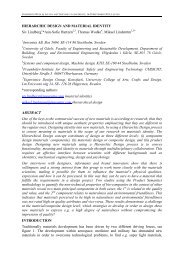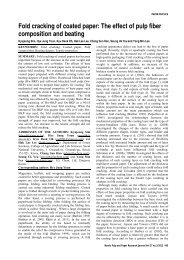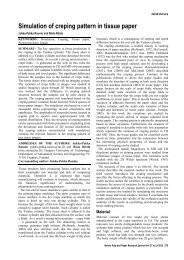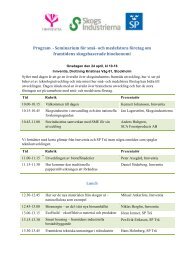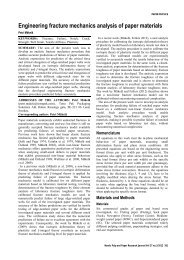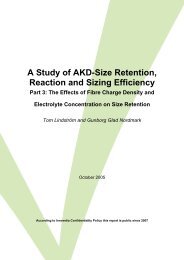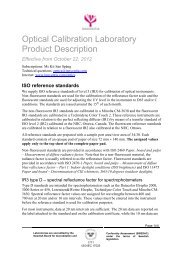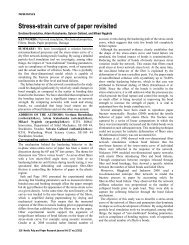3D network simulations of paper structure - Innventia.com
3D network simulations of paper structure - Innventia.com
3D network simulations of paper structure - Innventia.com
Create successful ePaper yourself
Turn your PDF publications into a flip-book with our unique Google optimized e-Paper software.
PAPER PHYSICS<br />
Fig 10. Simulated machine-made sample after <strong>com</strong>pression<br />
Fig 6. Fiber <strong>network</strong> from Fig. 3 after <strong>com</strong>pression<br />
ΔX<br />
ΔX<br />
L<br />
Fig 7. The sample with 50% mixture <strong>of</strong> s<strong>of</strong>twood and hardwood<br />
pulps<br />
Fig 8. Fiber <strong>network</strong> with high filler content – an example <strong>of</strong><br />
coating simulation<br />
Fig 9. Filler particles distribution in the fiber mat during coating<br />
formation<br />
Fig 11. Tensile test for elastic modulus calculations<br />
Fiber Network Applications<br />
Calculation <strong>of</strong> Apparent Elastic Modulus<br />
The apparent elastic modulus is calculated the same way<br />
as usually calculated from the physical tensile test. The<br />
sample length should be at least 1.2 times bigger than the<br />
longest fiber in the <strong>network</strong>, as re<strong>com</strong>mended in Heyden<br />
2000. The example <strong>of</strong> such sample is presented in Fig 11<br />
(sample length is 5 mm, width is 1 mm). Material <strong>of</strong><br />
fibers is isotropic elastic. Mechanical properties <strong>of</strong> single<br />
fibers <strong>of</strong> different dry wooden species can be found in<br />
(Bronkhorst 2003; Page et al. 1977; Katz et al 2008).<br />
Before the solution <strong>of</strong> elastic boundary-value problem,<br />
the <strong>network</strong> should be analyzed and bonds between fibers<br />
should be set up. A contact couple can be defined only<br />
between two elements which belong to two different<br />
fibers. From one to four links (bonds) may be set up in<br />
one contact couple. The stiffness <strong>of</strong> each bond is<br />
calculated from the value <strong>of</strong> contact area (overlapped area<br />
<strong>of</strong> two contact surfaces) and bonding stiffness,<br />
experimentally found by Thorpe et al. 1976. The average<br />
maximum shear stress reported by Thorpe et al. 1976 and<br />
Perkins 2001, for the holocellulose bond was<br />
corresponding to an average maximum strain<br />
. The bond stiffness parameter is obtained<br />
as<br />
and is equal to the<br />
spring force between each pair <strong>of</strong> bonding nodes. Fibers<br />
not bonded to other fibers <strong>of</strong> the <strong>network</strong> are eliminated<br />
from consideration. To solve the elastic problem, the<br />
kinematic boundary conditions should be applied to the<br />
finite element grid. Prescribed displacements are assigned<br />
to the nodes located on clamped area on the top and the<br />
bottom surfaces from two opposite sides <strong>of</strong> the sample,<br />
Fig 11.<br />
After solution <strong>of</strong> elastic problem, nodal displacements<br />
are used for calculation <strong>of</strong> strain and stress distributions<br />
in finite elements.<br />
Integration <strong>of</strong> stresses over element’s area in some<br />
sample cross-sections gives average force and average<br />
Nordic Pulp and Paper Research Journal Vol 27 no.2/2012 259



